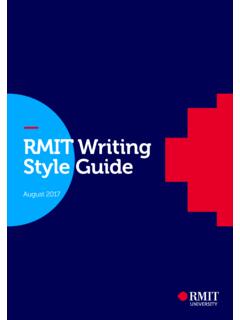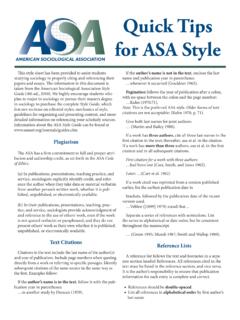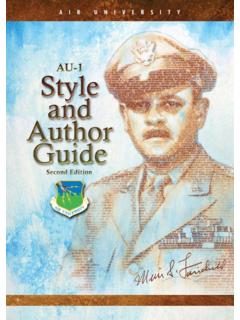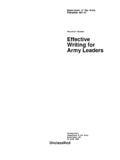Transcription of C.H. ROBINSON WRITING STYLE GUIDE
1 1 ROBINSON WRITING STYLE GUIDE We based these guidelines on the rules in Chicago Manual of STYLE , 17th edition, with special adaptations and guidelines specific to our business. For each item, the guidelines are listed, followed by the associated sections in the Chicago Manual of STYLE . ROBINSON -specific guidelines are listed as Ours. The table of contents is linked to each designated section, so you can jump directly to the section you re looking for. Or, you can utilize the search function in Adobe to locate keyword(s) throughout this WRITING STYLE GUIDE . For specific questions not answered by this GUIDE , please contact the Marketing department for assistance. Our general STYLE guidelines for most materials: Consider the audience. Keep it conversational. Avoid excessive use of industry jargon.
2 Use active voice vs. passive voice. Use short and varied sentence structure. Avoid excessive use of adjectives and adverbs. Reference the branding guidelines on the Brand Guidelines site. 2 VOICE AND TONE Across all our materials, we want to tell a cohesive, engaging story about ROBINSON . In order to do that, we need to tell a story that is relatable, customer-centric, relevant, and thematic. Attribute Personality Tone (how it comes across) Knowledgeable Has deep knowledge in transportation and logistics Demonstrates objective expertise (white papers & higher ed relationships) Intelligent, yet understanding Innovative, offering best practices and new ideas Relationship-oriented Shares analysis & data to help improve a customer s business Builds long-term relationships Able to tackle tough problems Encourages discussion to get things right Responsive Gives high-level customer service Always available Problem solves Never says no Accelerates the customer s advantage to work with us Global Can help you integrate a worldwide supply chain Connected to a world of logistics experts 3 CONTENTS VOICE AND TONE.
3 2 CONTENTS .. 3 CHANNEL-SPECIFIC GUIDELINES .. 4 WEB .. 4 SOCIAL MEDIA .. 4 PUNCTUATION & SYMBOLS .. 5 APOSTROPHES .. 5 AMPERSANDS .. 5 COLONS .. 5 COMMAS .. 5 CONTRACTIONS .. 6 DASHES .. 7 EXCLAMATION 7 HYPHENS .. 7 PARENTHESES .. 7 QUOTATION MARKS .. 8 SCIENTIFIC NOTATIONS (DEGREE, PERCENT) .. 8 SEMICOLONS .. 8 SPACING .. 8 FORMATTING .. 9 CAPITALIZATION .. 9 CURRENCY .. 10 DATES .. 10 DIRECTIONS AND REGIONS .. 11 END 11 PRODUCT NAMES AND COMPANY TITLES .. 11 ITALICS .. 13 LISTS .. 14 LOAD DIMENSIONS .. 14 NUMBERS .. 14 SEASONS .. 15 TELEPHONE NUMBERS .. 15 TIME .. 15 WEBSITES .. 15 4 GRAMMAR & STYLE .. 16 AP VS. 16 ASTERISKS .. 16 CITATIONS .. 17 COMMONLY MISUSED TERMS .. 18 GLOBAL REGIONS .. 18 PLURALS .. 20 POSSESSIVES .. 20 ROBINSON FRESH .. 20 QUOTES .. 21 WORD COUNTS.
4 21 SPELLING .. 22 ABBREVIATIONS .. 22 ACRONYMS .. 22 COMMON INDUSTRY AND TRANSPORTATION TERMS .. 24 GENERAL BUSINESS AND TECHNOLOGY TERMS .. 25 LEGAL GUIDE .. 26 CORPORATE NAME USAGE .. 26 SERVICE SPECIFIC LANGUAGE .. 26 WORDS TO AVOID IN COMMUNICATIONS .. 26 COPYRIGHT LEGENDS .. 27 INTERNAL USE ONLY LEGEND .. 27 LISTS .. 27 TRADEMARK AND SERVICEMARK USAGE POLICY .. 27 APPENDIX .. 30 COMMON PROOFREADING MARKS .. 30 CHANNEL-SPECIFIC GUIDELINES Web For rules and exceptions as they apply to our web presence, refer to the ROBINSON web toolkit. Social media For rules and exceptions as they apply to social media, refer to our social media STYLE GUIDE . 5 PUNCTUATION & SYMBOLS Apostrophes Add an apostrophe for plurals of a single lowercase letter. Do not add an apostrophe for plurals of a single uppercase letter.
5 Do not add an apostrophe unless the word shows ownership. Add an apostrophe after the s in possessive plurals. Do not add an apostrophe for the possessive its. Possessive pronouns versus contractions Use of the apostrophe Possessive of nouns in plural form, singular in meaning Plurals of letters Ampersands Ours Use ampersands in headers, subheads, and graphics when space is limited. Ours Avoid use in formal documents ( , RFPs, white papers, case studies), body copy, and URLs. Colons Colons are most commonly used at the end of a complete sentence to introduce a list. Do not use a colon to set off a list of single words or simple phrases, after forms of the verb to be. Place one space after a colon that combines two sentences; capitalize the first word after a colon that combines two sentences.
6 Use of the colon Run-in lists Vertical lists punctuation and format Commas Use commas to separate simple list elements. Include a comma before the conjunction ( , Oxford comma) in North America and India. Do not place a comma before or after an ampersand in a series. Include the comma in numbers over three digits. Use commas to set off elements in addresses and names of geographical places or political divisions. Use commas before and after the year when the month, day, and year are included in running text. Use commas before and after words like Inc. and Ltd. 6 Do not use a comma if only the month and year are included. Do not use commas after question marks when supplying credit for a quotation. Do not use commas before the words too or either. Good usage versus common usage ( and ) Serial commas Commas with question marks or exclamation points Omitting serial commas before ampersands Commas with dates Commas with addresses Commas with too and either Comma between digits Contractions Contractions are acceptable in sales materials if the goal is to remain conversational with the target audience.
7 Ours Contractions should be used sparingly in formal documents, such as RFPs and white papers and avoided entirely in translated materials. Contractions 7 Dashes There are three common dashes: Hyphens (-) are the shortest dash and are used to form compound words. En dashes ( ) are slightly longer than hyphens and shorter than em dashes, they represent a span or range of numbers, dates, or time. Em dashes ( ) are the longest dash. Use the em dash in place of parenthesis, colons, or commas especially when an abrupt break in thought is called for. Limit to one set per paragraph. Ours There are no spaces before or after an em dash. En dash as to Em dashes instead of commas, parentheses, or colons Exclamation points Use sparingly and avoid in headlines entirely.
8 Can be effectively used in email communications. Use of the exclamation point Hyphens Beyond industry-specific terms (see list), defer to Chicago Manual s GUIDE on hyphenation. Hyphenate compound adjectives before a noun, but not after Words formed with prefixes get no hyphens To hyphenate or not to hyphenate Hyphenation GUIDE - Hyphenate before a noun, but not after; , "Our real-time, door-to-door, best-in-class, high-value, same-day services/Our services are real time, door to door, best in class, high value, and same day" Parentheses Place a period outside a closing parenthesis if the material inside is not a sentence. Place the period inside the closing parenthesis if the material inside is a complete sentence. Parentheses with other punctuation 8 Quotation marks Enclose titles of articles, poems, short stories, songs, webinars, and lectures in quotation marks.
9 Periods and commas go inside the closing quotation mark. Use single quotation marks for quotes within quotes. Periods and commas in relation to closing quotation marks Italics versus quotation marks for titles and other terms Quotations and quotes within quotes See the chart in the Italics section, under Formatting, for treatment guidelines for specific titles. Scientific notations (degree, percent) Spell out degree in formal WRITING ( , white papers, case studies). Use the degree symbol ( ) in graphics and informal documents ( , blogs, emails, web pages). Always use a numeral when referring to a degree. ( , There was a 5-degree difference in temperatures. ) Always capitalize and spell out both Celsius and Fahrenheit. Spell out percent in the body content of formal WRITING ( , white papers), but the symbol is acceptable for informal documents ( , blogs and graphics).
10 Miscellaneous technical abbreviations Semicolons Use semicolons to separate items in a series when the items use internal commas. Place the final semicolon before the conjunction in the series. Semicolons in a complex series Spacing One space, not two, should follow periods and colons. Space between sentences or after colons 9 FORMATTING Capitalization In titles ( , web page, blogs, white papers, case studies) always capitalize the first and last words and all other major words. Lowercase the articles the, a, and an. Lowercase prepositions ( , about, before, by, for, in, than, etc.), regardless of length, except when they are stressed. Lowercase the conjunctions and, but, for, or, and nor. For subsequent headings, capitalize only the first word and all proper nouns.










